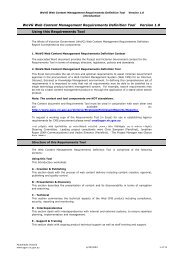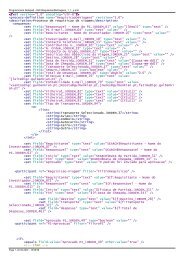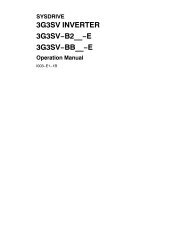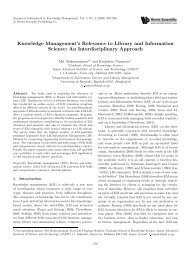2 Information Systems in the Enterprise - Main Web
2 Information Systems in the Enterprise - Main Web
2 Information Systems in the Enterprise - Main Web
Create successful ePaper yourself
Turn your PDF publications into a flip-book with our unique Google optimized e-Paper software.
4 Part I ❙ ORGANIZATIONS, MANAGEMENT, AND THE NETWORKED ENTERPRISE<br />
Management<br />
Challenges<br />
operational-level systems<br />
<strong>Information</strong> systems that monitor<br />
<strong>the</strong> elementary activities and<br />
transactions of <strong>the</strong> organization.<br />
Bus<strong>in</strong>esses need different types of <strong>in</strong>formation systems to support decision mak<strong>in</strong>g and<br />
work activities for various organizational levels and functions.To respond to new competitive<br />
pressures, many are implement<strong>in</strong>g enterprise-wide systems that <strong>in</strong>tegrate <strong>in</strong>formation<br />
and bus<strong>in</strong>ess processes from different functional areas. Alp<strong>in</strong>a, for <strong>in</strong>stance, needed <strong>in</strong>formation<br />
systems that would allow it to move its products more efficiently through its supply<br />
cha<strong>in</strong>. It found a solution <strong>in</strong> build<strong>in</strong>g systems that could l<strong>in</strong>k important bus<strong>in</strong>ess<br />
processes for sales, production, and logistics.The open<strong>in</strong>g vignette presents <strong>the</strong> potential<br />
rewards to firms with well-conceived systems l<strong>in</strong>k<strong>in</strong>g <strong>the</strong> entire enterprise. Such systems<br />
typically require a significant amount of organizational and management change and raise<br />
<strong>the</strong> follow<strong>in</strong>g management challenges:<br />
1. Integration. Although it is necessary to design different systems serv<strong>in</strong>g different<br />
levels, functions, and bus<strong>in</strong>ess processes <strong>in</strong> <strong>the</strong> firm, more and more firms are f<strong>in</strong>d<strong>in</strong>g<br />
advantages <strong>in</strong> <strong>in</strong>tegrat<strong>in</strong>g systems. However, <strong>in</strong>tegrat<strong>in</strong>g systems for different organizational<br />
levels, functions, and bus<strong>in</strong>ess processes to freely exchange <strong>in</strong>formation can<br />
be technologically difficult and costly. Managers need to determ<strong>in</strong>e what level of system<br />
<strong>in</strong>tegration is required and how much it is worth <strong>in</strong> dollars.<br />
2. Enlarg<strong>in</strong>g <strong>the</strong> scope of management th<strong>in</strong>k<strong>in</strong>g. Most managers are tra<strong>in</strong>ed to<br />
manage a product l<strong>in</strong>e, a division, or an office.They are rarely tra<strong>in</strong>ed to optimize <strong>the</strong><br />
performance of <strong>the</strong> organization as a whole, and often are not given <strong>the</strong> means to<br />
do so. But enterprise systems and <strong>in</strong>dustrial networks require managers to take a<br />
much larger view of <strong>the</strong>ir own behavior to <strong>in</strong>clude o<strong>the</strong>r products, divisions, departments,<br />
and even outside bus<strong>in</strong>ess firms. Investments <strong>in</strong> enterprise systems are huge,<br />
<strong>the</strong>y must be developed over long periods of time, and <strong>the</strong>y must be guided by a<br />
shared vision of <strong>the</strong> objectives.<br />
In this chapter we exam<strong>in</strong>e <strong>the</strong> role of <strong>the</strong> various types of <strong>in</strong>formation systems <strong>in</strong> organizations.<br />
First we look at ways of classify<strong>in</strong>g <strong>in</strong>formation systems based on <strong>the</strong> organizational<br />
level <strong>the</strong>y support. Next we look at systems <strong>in</strong> terms of <strong>the</strong> organizational function <strong>the</strong>y<br />
serve. We <strong>the</strong>n show how systems can support bus<strong>in</strong>ess processes, <strong>in</strong>clud<strong>in</strong>g processes spann<strong>in</strong>g<br />
more than one function, such as customer relationship management and supply cha<strong>in</strong><br />
management. F<strong>in</strong>ally, we exam<strong>in</strong>e enterprise systems and <strong>in</strong>dustrial networks, which enable<br />
organizations to <strong>in</strong>tegrate <strong>in</strong>formation and bus<strong>in</strong>ess processes across entire firms and even<br />
entire <strong>in</strong>dustries.<br />
2.1 Key System Applications <strong>in</strong> <strong>the</strong><br />
Organization<br />
Because <strong>the</strong>re are different <strong>in</strong>terests, specialties, and levels <strong>in</strong> an organization, <strong>the</strong>re are different<br />
k<strong>in</strong>ds of systems. No s<strong>in</strong>gle system can provide all <strong>the</strong> <strong>in</strong>formation an organization<br />
needs. Figure 2-1 illustrates one way to depict <strong>the</strong> k<strong>in</strong>ds of systems found <strong>in</strong> an organization.<br />
In <strong>the</strong> illustration, <strong>the</strong> organization is divided <strong>in</strong>to strategic, management, knowledge, and<br />
operational levels and <strong>the</strong>n is fur<strong>the</strong>r divided <strong>in</strong>to functional areas such as sales and market<strong>in</strong>g,<br />
manufactur<strong>in</strong>g, f<strong>in</strong>ance, account<strong>in</strong>g, and human resources. <strong>Systems</strong> are built to serve<br />
<strong>the</strong>se different organizational <strong>in</strong>terests (Anthony, 1965).<br />
Different K<strong>in</strong>ds of <strong>Systems</strong><br />
Four ma<strong>in</strong> types of <strong>in</strong>formation systems serve different organizational levels: operationallevel<br />
systems, knowledge-level systems, management-level systems, and strategic-level systems.<br />
Operational-level systems support operational managers by keep<strong>in</strong>g track of <strong>the</strong> elementary<br />
activities and transactions of <strong>the</strong> organization, such as sales, receipts, cash deposits,<br />
payroll, credit decisions, and <strong>the</strong> flow of materials <strong>in</strong> a factory. The pr<strong>in</strong>cipal purpose of systems<br />
at this level is to answer rout<strong>in</strong>e questions and to track <strong>the</strong> flow of transactions through<br />
<strong>the</strong> organization. How many parts are <strong>in</strong> <strong>in</strong>ventory? What happened to Mr. Williams’s pay












